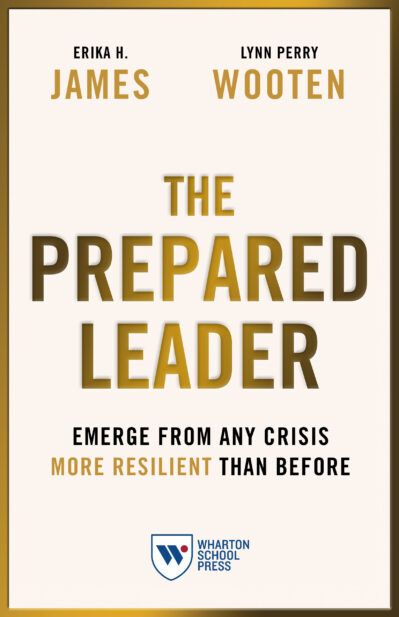
In an excerpt from their book ‘The Prepared Leader,’ Erika James and Lynn Perry Wooten lay down five steps to becoming a more prepared leader in times of crisis.


Erika H. James, Lynn Perry Wooten
In The Prepared Leader: Emerge from Any Crisis More Resilient Than Before, two crisis leadership experts — Wharton Dean Erika H. James and Lynn Perry Wooten, president of Simmons University — provide tools and frameworks for addressing and learning from crises. In the following excerpt from their book, James and Wooten identify the five phases of crisis management.
Twice a day, the common swift performs something called a vesper flight. The bird ascends to the planetary boundary layer — a part of the atmosphere that is characterized by convective currents and air thermals. At this altitude, swifts do more than sleep. They proactively use the wind to assess how weather systems far ahead might change or evolve. They use signs and signals around them to forecast shifts in their environment high above the planet. In other words, the vesper flight takes swifts to such altitudes that they can read the atmosphere, locate their own position, and plan accordingly.
In an essay published by the New York Times in July 2020, British writer Helen Macdonald mused about what swifts can teach us about making decisions in the face of oncoming bad weather. Most of the time, these birds remain below the boundary layer, she writes. But to find out about the important things that will affect their lives, they must “go higher to survey the wider scene, and there communicate with others about the larger forces impinging on their realm.”
Not all of us need to make that climb, just as many swifts eschew their vesper flights because they are occupied with eggs and young — but surely some of us are required, by dint of flourishing life and the well-being of us all, to look clearly at the things that are so easily obscured by the everyday. To take time to see the things we need to set our courses toward or against; the things we need to think about to know what we should do next. To trust in careful observation and expertise, in its sharing for the common good….
Scanning the environment, seeing the signs, interpreting cues, and making sense of them is something so completely innate in nature, wholly native to migratory animals, and so hardwired in their instinctive behavior and decision-making that it prompts the question: Why do human beings so frequently fail to go higher?
Macdonald’s essay highlights something critically important: The best way to survive a crisis is to watch for it and see it coming before it’s too late. It is about catching sight of the threat soon enough to avert it or contain the worst and giving yourself and your organization the maneuverability to prepare, mitigate damage, and plan efficiently for recovery.
This is the first phase of crisis management.
Crises seem to occur instantaneously. But they play out over time. During the last 20 years, as we’ve researched crises, we’ve seen five distinguishable phases that characterize crisis management.
When we think about crises, we tend to think about damage control or limitation. In fact, this is only one element. There are things that happen before we get to the point of firefighting, and things that happen afterward: Scanning, preparing, managing, recovering, and reflective learning all form part of the whole.
Your first step toward becoming a Prepared Leader is to grasp that each of these different phases entails specific skills and behaviors to manage proactively, systematically, and effectively. The key thing is to remember that as a Prepared Leader, you have agency. You can act at each one of these different phases and make a huge difference in the end result.
We know that crises happen. We just don’t know where, when, or how they will strike, or what kind of crisis they will be.
Once you have detected the signs, the next phase is about enacting proactive measures that can (ideally) prevent the crisis, or at least help you brace for its impact.
When a crisis does strike, what happens next is critical both in terms of containment and damage control. It also determines how you and your organization will progress to the next phase: recovery.
One of your most ambitious goals in crisis management will be to recover: to recoup time, resources, and revenue lost and to bounce back—or, actually, to bounce forward, better than before. Business recovery is your North Star.
Reflecting and finding ways to leverage the crisis experience will lead to the prevention or mitigation of future crises.
Breaking crisis management down into these five phases will help you rationalize what is at stake and what you need to do at each phase.
Knowing that crises unfold across these phases, you can also pinpoint the kinds of skills you need to progress from one phase to the next. Because effective crisis leadership requires several critical competencies that go beyond day-to-day general management aptitudes.
Simply put, in a crisis, more is expected of your leadership.
Prepared Leadership is the ability to lead under these amplified pressures and demands. It is the capacity to confront threats and take the right risks, precisely at the moment when our human tendency is to defend, retreat, and avoid threats. During times of crisis, Prepared Leaders need to be able to expand their skill set to meet these new demands and leverage positive change for themselves, others, their organizations, and their communities.
Excerpted from The Prepared Leader: Emerge from Any Crisis More Resilient Than Before, by Erika H. James and Lynn Perry Wooten, copyright 2022. Reprinted by permission of Wharton School Press.

Get The Prepared Leader, by Erika H. James and Lynn Perry Wooten.